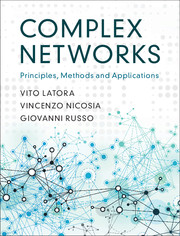Book contents
- Frontmatter
- Dedication
- Contents
- Preface
- Introduction
- Epigraph
- 1 Graphs and Graph Theory
- 2 Centrality Measures
- 3 Random Graphs
- 4 Small-World Networks
- 5 Generalised Random Graphs
- 6 Models of Growing Graphs
- 7 Degree Correlations
- 8 Cycles and Motifs
- 9 Community Structure
- 10 Weighted Networks
- Appendices
- References
- Author Index
- Index
1 - Graphs and Graph Theory
Published online by Cambridge University Press: 11 October 2017
- Frontmatter
- Dedication
- Contents
- Preface
- Introduction
- Epigraph
- 1 Graphs and Graph Theory
- 2 Centrality Measures
- 3 Random Graphs
- 4 Small-World Networks
- 5 Generalised Random Graphs
- 6 Models of Growing Graphs
- 7 Degree Correlations
- 8 Cycles and Motifs
- 9 Community Structure
- 10 Weighted Networks
- Appendices
- References
- Author Index
- Index
Summary
Graphs are the mathematical objects used to represent networks, and graph theory is the branch of mathematics that deals with the study of graphs. Graph theory has a long history. The notion of the graph was introduced for the first time in 1763 by Euler, to settle a famous unsolved problem of his time: the so-called Königsberg bridge problem. It is no coincidence that the first paper on graph theory arose from the need to solve a problem from the real world. Also subsequent work in graph theory by Kirchhoff and Cayley had its root in the physical world. For instance, Kirchhoff's investigations into electric circuits led to his development of a set of basic concepts and theorems concerning trees in graphs. Nowadays, graph theory is a well-established discipline which is commonly used in areas as diverse as computer science, sociology and biology. To give some examples, graph theory helps us to schedule airplane routing and has solved problems such as finding the maximum flow per unit time from a source to a sink in a network of pipes, or colouring the regions of a map using the minimum number of different colours so that no neighbouring regions are coloured the same way. In this chapter we introduce the basic definitions, setting up the language we will need in the rest of the book. We also present the first data set of a real network in this book, namely Elisa's kindergarten network. The two final sections are devoted to, respectively, the proof of the Euler theorem and the description of a graph as an array of numbers.
What Is a Graph?
The natural framework for the exact mathematical treatment of a complex network is a branch of discrete mathematics known as graph theory [48, 47, 313, 150, 272, 144]. Discrete mathematics, also called finite mathematics, is the study of mathematical structures that are fundamentally discrete, i.e. made up of distinct parts, not supporting or requiring the notion of continuity. Most of the objects studied in discrete mathematics are countable sets, such as integers and finite graphs. Discrete mathematics has become popular in recent decades because of its applications to computer science. In fact, concepts and notations from discrete mathematics are often useful to study or describe objects or problems in computer algorithms and programming languages. The concept of the graph is better introduced by the two following examples.
- Type
- Chapter
- Information
- Complex NetworksPrinciples, Methods and Applications, pp. 1 - 30Publisher: Cambridge University PressPrint publication year: 2017



